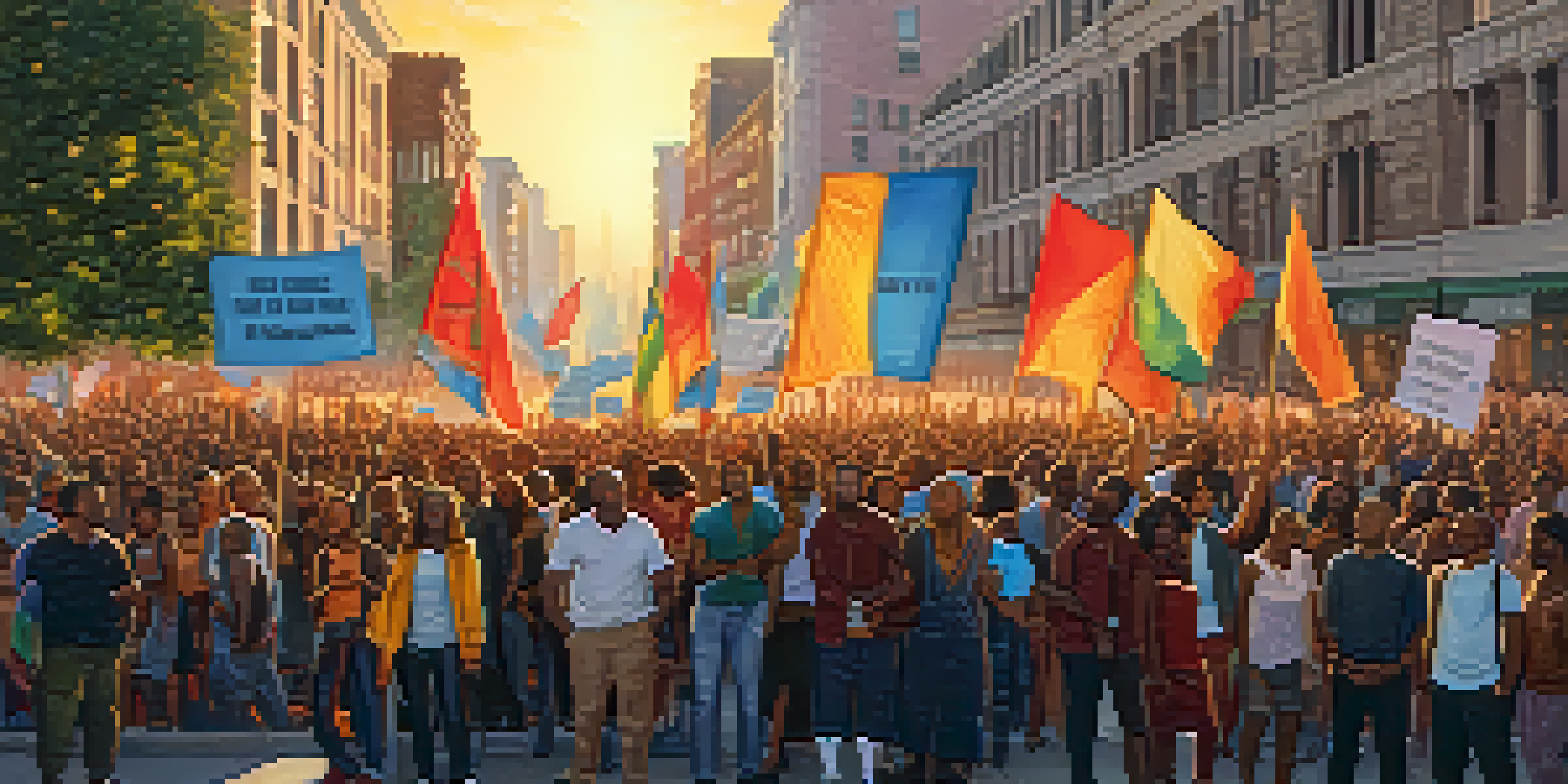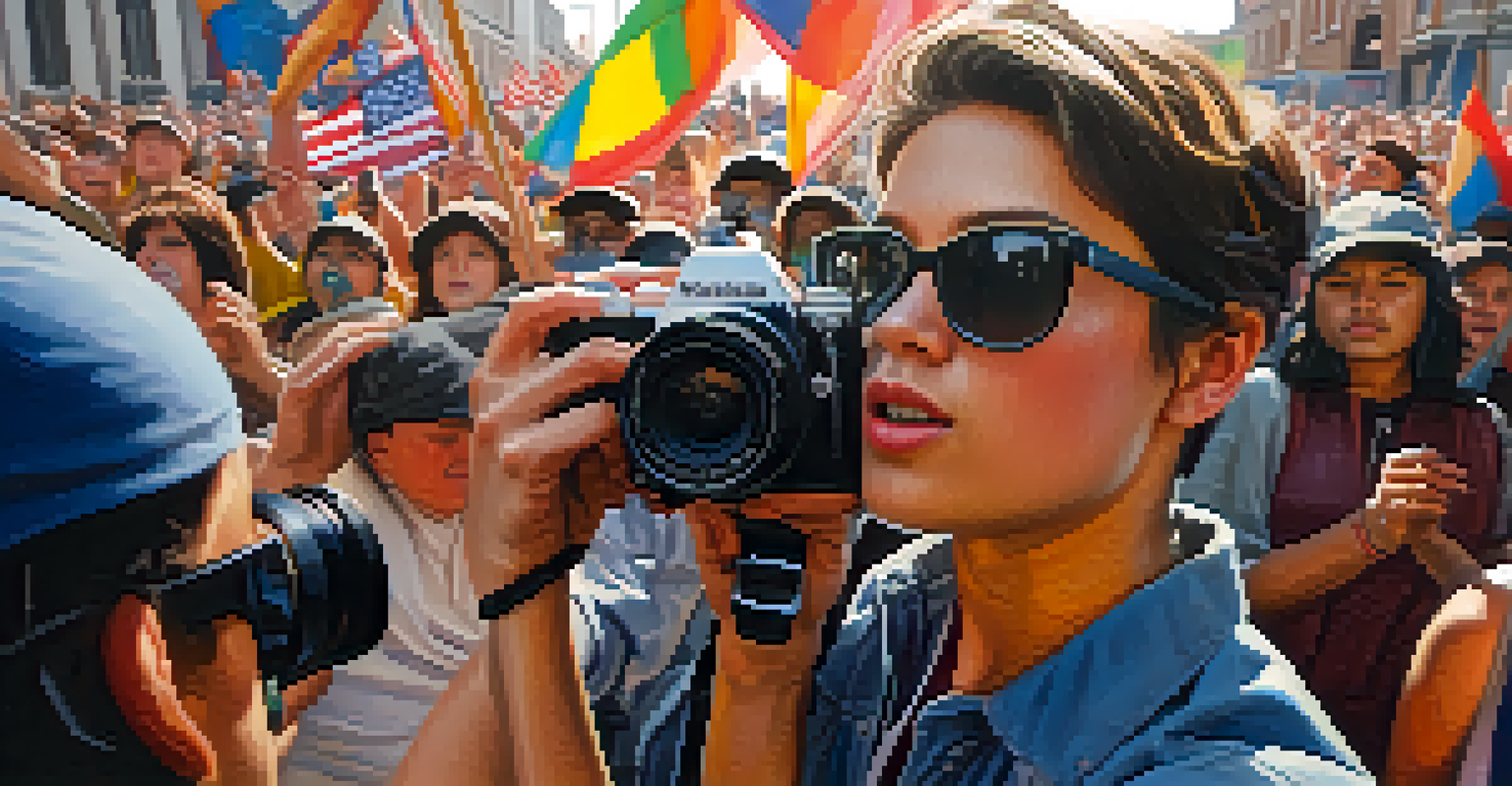Cinematography of Protest: Film as a Tool for Activism

The Role of Film in Social Movements
Film has long served as a powerful medium for social change, capturing the essence of protests and movements. By portraying the struggles of marginalized groups, filmmakers can evoke empathy and understanding from audiences. Think of iconic documentaries that brought issues like civil rights or climate change into the spotlight; these films not only inform but also inspire action.
Film is a powerful tool for social change, capable of inspiring audiences to take action and engage in activism.
When people see real stories through the lens of a camera, they often feel a personal connection to the issues presented. This connection can motivate them to join the cause or support activist efforts. For example, films like '13th' or 'The Act of Killing' challenge viewers to confront uncomfortable truths about society and its injustices.
Furthermore, the visual nature of film makes complex issues more accessible, breaking down barriers of understanding. With compelling narratives and striking imagery, filmmakers can simplify nuanced topics, making them relatable and urgent. This is why film remains an essential tool for raising awareness and fostering activism.
Visual Storytelling: Impact on Public Perception
Visual storytelling is a unique aspect of cinematography that can significantly influence public perception. Through carefully crafted images and sequences, filmmakers can shape how audiences view social issues. For instance, a powerful shot of a protestor standing defiantly can evoke feelings of courage and resilience, galvanizing support for a movement.

Moreover, film can humanize abstract statistics and facts, turning them into relatable stories. By showcasing individual experiences, the audience can see the human cost of social issues, leading to greater empathy. This emotional appeal often drives viewers to take action, whether that means attending protests or advocating for policy changes.
Film Drives Social Change
Documentaries and films evoke empathy and inspire action by presenting the struggles of marginalized groups.
In this way, cinematography not only documents the moment but also shapes the narrative around it. As viewers engage with these stories, their understanding evolves, and so does their willingness to act on behalf of the cause being portrayed.
Historical Context: Filmmaking and Activism
Historically, filmmakers have played a crucial role in documenting activism and social change. From the anti-war films of the 1960s to modern-day documentaries about climate activism, cinema has mirrored societal struggles. This relationship between film and activism is not just coincidental; it reflects a deep-seated desire to influence public discourse and policy.
The great thing about film is that it can reach people in a way that a lecture or an article cannot.
For instance, the film 'Selma' not only tells the story of a pivotal moment in the civil rights movement but also serves as a reminder of the ongoing fight for equality. By connecting past struggles to current issues, filmmakers can create a sense of urgency and continuity that resonates with audiences.
As we look back, we see how filmmakers have often been at the forefront of social movements, using their art to educate and mobilize the public. This historical perspective enriches our understanding of the impact of film on activism today.
Digital Age: New Platforms for Activist Filmmaking
The rise of digital platforms has transformed the landscape of activist filmmaking. Social media, streaming services, and online video sharing have made it easier for filmmakers to reach a global audience. This democratization of film distribution allows diverse voices to share their stories and perspectives, often highlighting issues that mainstream media might overlook.
For example, platforms like YouTube and TikTok have empowered young activists to create and share short films that capture their experiences and calls for change. This shift not only broadens the reach of activist messages but also fosters a sense of community and solidarity among viewers.
Visual Storytelling Shapes Perception
Cinematography can transform abstract social issues into relatable narratives that encourage public engagement.
As a result, the digital age has opened new avenues for storytelling, encouraging a more participatory approach to activism. Filmmakers can engage directly with their audience, fostering dialogue and inspiring collective action.
Case Studies: Films that Sparked Change
Several films have made significant impacts on social movements, serving as catalysts for change. For example, 'Blackfish' raised awareness about the captivity of orcas and prompted public backlash against SeaWorld. Its compelling narrative and emotional storytelling galvanized viewers, leading to widespread calls for reform and change in marine parks.
Another notable case is 'The Square,' which chronicles the Egyptian Revolution and the struggles faced by activists. The film not only documents the protests but also highlights the personal sacrifices made by individuals fighting for freedom. This intimate portrayal encourages viewers to reflect on their own roles in social change.
These case studies illustrate the profound potential of film to not only inform but also mobilize audiences. By showcasing real-life stories, these films inspire viewers to take action and become part of the solution.
Challenges Faced by Activist Filmmakers
Despite the power of film as a tool for activism, filmmakers often face significant challenges. Issues such as funding, censorship, and access to resources can hinder the production of impactful films. Independent filmmakers may struggle to secure financing, which can limit their ability to produce high-quality content that addresses urgent social issues.
Moreover, censorship remains a pressing concern, particularly in regions where dissent is not tolerated. Activist filmmakers may risk their safety or face legal repercussions for telling stories that challenge the status quo. This reality adds a layer of complexity to the already difficult task of creating impactful films.
Challenges for Activist Filmmakers
Independent filmmakers face obstacles like funding and censorship, yet they persist in sharing impactful stories.
Despite these challenges, many filmmakers persevere, driven by a commitment to their causes. Their resilience highlights the importance of supporting independent voices in the film industry to ensure diverse perspectives continue to be represented.
Future of Activist Filmmaking: Trends to Watch
As we look to the future, several trends are emerging in the realm of activist filmmaking. One notable trend is the increasing use of virtual reality (VR) and augmented reality (AR) to create immersive experiences that engage audiences on a deeper level. These technologies allow viewers to step into the shoes of those affected by social issues, fostering empathy and understanding.
Another trend is the collaboration between filmmakers and grassroots organizations. By working together, they can amplify their messages and reach wider audiences. This partnership can also help ensure that stories are told authentically and represent the voices of those directly impacted.

Ultimately, the future of activist filmmaking holds promise as new technologies and collaborative efforts emerge. As filmmakers continue to innovate and adapt, they will remain vital in the ongoing struggle for social justice and change.